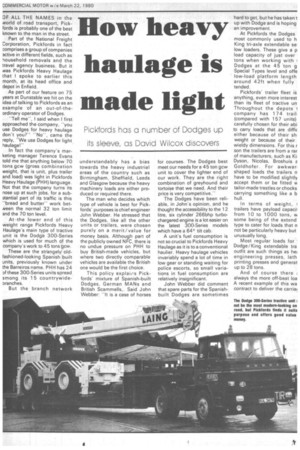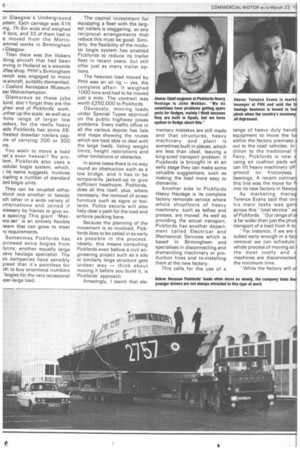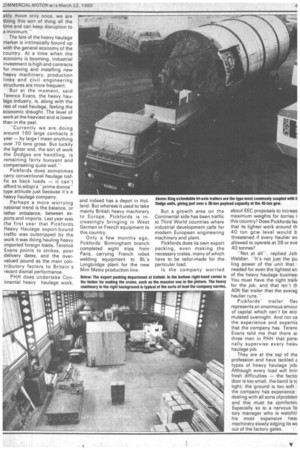How heavy haulage is
Page 47

Page 48

Page 49

If you've noticed an error in this article please click here to report it so we can fix it.
made light Pickfords has a number of Dodges u 0 Its sleeve, as David Wilcox discovers
OF ALL THE NAMES in the NorId of road transport, Pickfords is probably one of the best known to the man in the street.
Part of the National Freight corporation, Pickfords in fact comprises a group of companies active in different fields, such as nousehold removals and the travel agency business. But it was Pickfords Heavy Haulage that I spoke to earlier this month, at its head office and depot in Enfield.
As part of our feature on 75 years at Dunstable we hit on the idea of talking to Pickfords as an example of an out-of-theordinary operator of Dodges. 'Tell me'', I said when I first approached the company, you use Dodges for heavy haulage don't you?'' "No", came the reply, "We use Dodges for light naulage!"
In fact the company's marketing manager Terence Evans told me that anything below 70 tons gcw (gross combination weight, that is unit, plus trailer and load) was light in Pickfords Heavy Haulage (PH H) language. Not that the company turns its nose up at such jobs, for a sub3tantial part of its traffic is this "bread and butter" work betNeen the normal 32 ton limit 3n d the 70 ton level.
At the lower end of this weight range Pickfords Heavy Haulage's main type of tractive unit is the Dodge 300-Series which is used for much of the company's work to 45 tons gcw.
These are the strangely oldfashioned-looking Spanish built units, previously known under the Barreiros name. PH H has 24 pf these 300-Series units spread 3mong its 15 countrywideDrenches.
But the branch network understandably has a bias towards the heavy industrial areas of the country such as Birmingham, Sheffield, Leeds and Glasgow because the heavy machinery loads are either produced or required there.
The man who decides which type of vehicle is best for Pickfords' purposes is chief engineer John Webber. He stressed that the Dodges, like all the other units or trailers, were chosen purely on a merit/value for money basis. Although part of the publicly owned NFC, there is no undue pressure on PHH to buy British-made vehicles, but where two directly comparable vehicles are available the British one would be the first choice.
This policy explaii-s Pickfords' mixture of Spanish-built Dodges, German MANs and British Scammells,. Said John Webber: "It is a case of horses for courses. The Dodges best meet our needs for a 45 ton gcw unit to cover the lighter end of our work. They are the right combination of greyhound and tortoise that we need. And their price is very competitive."' The Dodges have been reliable, in John's opinion, and he thought the accessibility to the 12 litre, six cylinder 266bhp turbocha rgered engine is a lot easier on the latest 300-Series models which have a 64° tilt cab.
A unit's fuel consumption is not so crucial to Pickfords Heavy Haulage as it is to a conventional haulier. Heavy haulage vehicles invariably spend a lot of time in low gear or standing waiting for police escorts, so small variations in fuel consumption are relatively insignificant.
John Webber did comment that spare parts for the Spanishbuilt Dodges are sometimes hard to get, but he has taken t up with Dodge and is hoping an improvement.
At Pickfords the Dodges most commonly used to h King tri-axle extendable se, low loaders. These give a p load capacity of just over tons when working with 1 Dodges at the 45 ton g Special Types level and offe low-load platform length around 42ft when fully tended.
Pickfords' trailer fleet is anything, even more interest than its fleet of tractive un Throughout the depots 1 company has 174 trail, (compared with 157 units) carefully chosen for their abi to carry loads that are diffic either because of their sh, weight or because of their wieldy dimensions. For this r son the trailers are from a rar of manufacturers, such as Ki, Dyson, Nicolas, Broshuis Goldhofer. For awkwar, shaped loads the trailers n have to be modified slightly accept them or be fitted vs, tailor-made trestles or chocks carrying something like a b hull.
In terms of weight, 1 trailers have payload capacii from 10 to 1000 tons, w some being of the extend type to cater for loads that n not be particularly heavy but unusually long.
Most regular loads for Dodge/King extendable tra outfit are such things as he .engineering presses, lath printing presses and generat up to 28 tons.
And of course there always the more off-beat loa A recent example of this wa contract to deliver the carnal or Glasgow's Underground 'stem. Each carriage was 41 ft ing, 7ft 81n wide and weighed 4 tons, and 33 of them had to e moved from the Metroammel works in Birmingham ) Glasgow.
Then there was the Vickers iking aircraft that had been :rving in Holland as a wayside offee shop. PH H's Birmingham ranch was engaged to move le aircraft, suitably dismantled, Cosford Aerospace Museum ear Wolverhampton.
Glamorous as these jobs mind, don't forget they are the ghter end of Pickfords' work. irther up the scale, as well as a 'hole range of larger low laders, for the really heavy lads Pickfords has some 48heeled drawbar trailers capDie of carrying 200 or 300 ins.
You want to move a load iat's even heavier? No prolem. Pickfords also uses a iodular bogie system, which, ; its name suggests, involves Kipling a number of standard zed bogie units.
They can be coupled either ?hind one another or beside
ich other in a wide variety of mbinations and joined if .:cessary by frames to give exa spacing. This giant "Mecino set" is an entirely flexible 'stem that can grow to meet ly requirements.
Sometimes Pickfords has orrowed extra bogies from /ynns, another equally large .avy haulage specialist. The vo companies have sensibly jreed that it's pointless for )th to buy enormous numbers • bogies for the very occasional iper-large load. The capital investment for equipping a fleet with the largest trailers is staggering, so any reciprocal arrangements that reduce this must be good. Similarly, the flexibility of the modular bogie system has enabled Pickfords to reduce its trailer fleet in recent years, but still offer just as many trailer options.
The heaviest load moved by PHH was an oil rig — yes, the complete affair. It weighed 1000 tons and had to be moved Just a mile. The contract was worth £250,000 to Pickfords.
Obviously, moving loads under Special Types approval on the public highway poses problems. Every traffic office in all the various depots has lists and maps showing the routes which are best able to deal with the large loads, listing weight limits, height restrictions and other limitations or obstacles.
In some cases there is no way round an obstruction such as a low bridge, and it has to be temporarily jacked-up to give sufficient headroom. Pickfords, does all this itself, plus, where necessary, the removal of street furniture such as signs or bollards. Police escorts will also help clear a path for the load and enforce packing bans.
Because the planning of the movement is so involved, Pickfords likes to be called in as early as possible in the process.
Ideally, this means consulting Pickfords even before a civil en gineering project such as a silo or similarly large structure gets undeer way — think about moving it before you build it, is Pickfords' approach.
Amazingly, I learnt that ele
mentary mistakes are still made and that structures, heavy machinery and plant is sometimes built in places, which are less than ideal, leaving a king-sized transport problem. If Pickfords is brought in at an early stage they can make some valuable suggestions, such as making the load more easy to dismantle.
Another side to Pickfords Heavy Haulage is its complete factory removals service where whole shopfloors of heavy machinery, such as lathes and presses, are moved. As well as providing the actual transport, Pickfords has another department called Electrical and Mechanical Services which is based in Birmingham and specialises in disconnecting and dismantling machinery or production lines and re-installing them at the new factory.
This calls for the use of a
range of heavy duty hand' equipment to move the loz within the factory premises a out to the road vehicles. In ; dition to the traditional Ir Fairy, Pickfords is now a using air cushion pads wh can lift heavy machinery off • ground on frictionless bearings. A recent contract this line was the move for F'l into its new factory in Newpo As marketing manag Terence Evans said that one his main tasks was getti across this "total servicean of Pickfords. "Ou'rrangeofsk is far wider than just the phys transport of a load from A to -For instance, if we are c suited early enough in a fact removal we can schedule whole process of moving so t the most costly and v machines are disconnected the minimum time.
'While the factory will pr ably move only once, we are doing this sort of thing all the time and can keep disruption to a minimum."
The fate of the heavy haulage market is intrinsically bound up with the general economy of the country. At a time when the economy is booming, industrial investment is high and contracts for moving and installing new heavy machinery, production lines and civil engineering structures are more frequent.
But at the moment, said Terence Evans, the heavy haulage industry, is, along with the rest of road haulage, feeling the economic draught. The level of work at the heaviest end is lower than in the past.
"Currently we are doing around 180 large contracts a year — by large I mean anything over 70 tons gross. But luckily the lighter end, the sort of work the Dodges are handling, is remaining fairly buoyant and compensating quite well."
Pickfords does sometimes carry conventional haulage traffic as back loads — it can't afford to adopt a "prima donna" type attitude just because it's a heavy haulage company.
Perhaps a more worrying national trend is thebalance,or rather imbalance, between ex
ports and imports. Last year was the first year that Pickfords Heavy Haulage export-bound traffic was outstripped by the work it was doing hauling heavy imported foreign loads. Terence Evans points to strikes, poor delivery dates, and the over valued pound as the main contributory factors to Britain's recent dismal performance.
PHH does undertake Continental heavy haulage work, and indeed has a depot in Holland. But whereas it used to take mainly British heavy machinery to Europe, Pickfords is increasingly bringing in West German or French equipment to this country.
Only a few months ago, Pickfords' Birmingham branch completed eight trips from Paris, carrying French robot welding equipment to BL's Longbridge plant for the new Mini Metro production line. But a growth area on the Continental side has been traffic to Third World countries where industrial development calls for modern European engineering machinery and plant.
Pickfords does its own export packing, even making the necessary crates, many of which have to be tailor-made for the particular load.
Is the company worried
about EEC proposals to increas maximum weights for lorries i this country? Does Pickfords feE that its lighter work around th 40 ton gcw level would b threatened if every haulier WE allowed to operate at 38 or eve 40 tonnes?
"Not at all", replied Joh Webber. "It's not just the pu ling power of the unit that needed for even the lightest en of the heavy haulage busines: You must have the right trail( for the job, and that isn't th 40ft flat trailer that the averag haulier runs."
Pickfords' trailer fle( represents an enormous amour of capital which can't be acci mulated overnight. And nor ca the experience and expertis that the company has. Terenc Evans told me that there ar three men in PHH that pers( nally supervise every heav haulage job.
They are at the top of the profession and have tackled e types of heavy haulage job! Although every load will brin fresh difficulties — the factoi door is too small, the bend is tc tight, the ground is too soft the company has experience r dealing with all sorts ofproblerr and this must be comfortin! Especially so to a nervous fa tory manager who is watchir his most expensive hea% machinery slowly edging its WE out of the factory gates.
































































































































